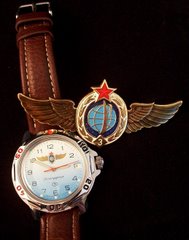 Back from the Watchmaker is my 1950's Rodina (Motherland) automatic watch made by the 1st Moscow Watch Factory (Poljot).
Back from the Watchmaker is my 1950's Rodina (Motherland) automatic watch made by the 1st Moscow Watch Factory (Poljot).A 22 Jewel automatic, this was the the first automatic design produced in the USSR. Also known as a Kirova after the founder of the 1st Moscow Watch Factory.
From the Poljot watch site:
"By 1955, 1.1 million mechanical wristwatches were made by the 1st MWF. In 1956 production of the first automatic movement watches under the Rodina (Fatherland) brand started. The Rodina watch opened a new line of watch movements with the 24 mm caliber. They have a central second hand. The height of the movement was 6.3 mm, with 22 jewels."Though no definitive proof exists to my knowledge, it has been suggested that Yuri Gagarin the first man in space wore a Rodina watch on his first flight into space.
One of the notable things about this watch is the clear audible clicking sound of the self winding system. My watchmaker was much impressed with the quality of the mechanism and gave it a favourable comparison to more expensive and well known Swiss brands.
Some pictures of the back and mechanism:
My watch was likely an export model as evidenced by the English script on the back and the obverse of the back.






